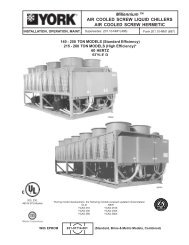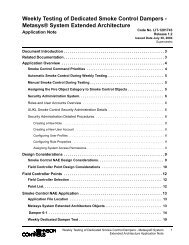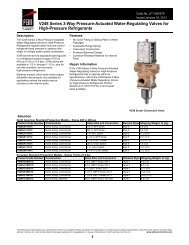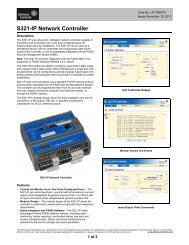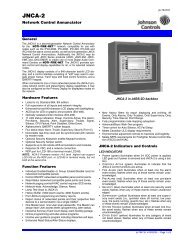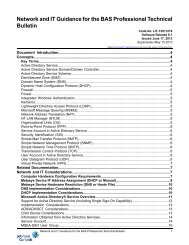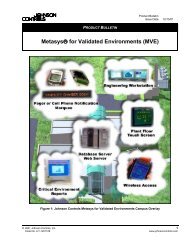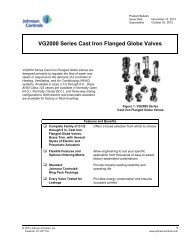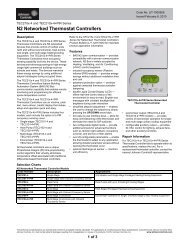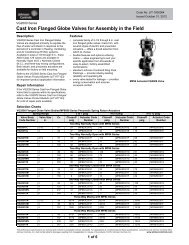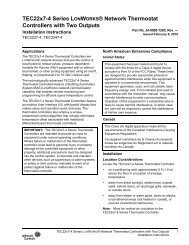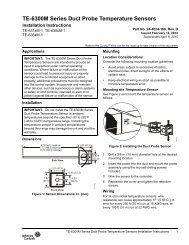TEC Zoning Control System for Stand-Alone and BACnet® MS/TP ...
TEC Zoning Control System for Stand-Alone and BACnet® MS/TP ...
TEC Zoning Control System for Stand-Alone and BACnet® MS/TP ...
- No tags were found...
You also want an ePaper? Increase the reach of your titles
YUMPU automatically turns print PDFs into web optimized ePapers that Google loves.
Table 9: Maximum Heat Flow Adjustment (Part 2 of 2)Reheat Stage(RehtConfParameter)(2): On/Off DuctReheat Only(3): On/OffPeripheral ReheatOnly(4): Analog DuctReheat <strong>and</strong> On/OffPeripheral ReheatTime Base <strong>for</strong>Reheat Output(BO5 TimeParameter)(0): 15 Minutes(Four Cycles perHour)(1): 10 Seconds(Six Cycles perHour) <strong>for</strong> SolidState Relays(0): 15 Minutes(Four Cycles perHour)(1): 10 Seconds(Six Cycles perHour) <strong>for</strong> SolidState RelaysN/AMaximum Heat Flow Adjustment(MaxH<strong>TP</strong>os Parameter)Adjust the maximum heat flow to any value higher thanthe current selected minimum position.Example: The minimum airflow is set at 25% <strong>and</strong> themaximum heat flow is set at 75%. If the primary air iscold, when the BO5 output is energized on a call <strong>for</strong>heat, the zone damper moves directly from 25% opento 75% open. As soon as the BO5 output isde-energized, the zone damper returns to 25% open.Adjust the maximum heat flow to any value higher thanthe current selected minimum position.Example: The minimum airflow is set at 25% <strong>and</strong> themaximum heat flow is set at 75%. If the primary air iscold, when the BO5 output is energized on a call <strong>for</strong>heat, the zone damper moves directly from 25% opento 75% open. As soon as the BO5 output isde-energized, the zone damper returns to 25% open.Leave the maximum heat flow at its default setting of30%, or adjust it to any other setting. The maximumheat flow adjustment is not used in this scenario.Leave the maximum heat flow at its default setting of30%, or adjust it to any other setting. The maximumheat flow adjustment is not used in this scenario.Adjust the maximum heat flow to any value higher thanthe current selected minimum position.Example: The minimum airflow is set at 25% <strong>and</strong> themaximum heat flow is set at 75%. If the primary air iscold, when the PI heating loop (<strong>and</strong> analog output)goes from 0 to 100%, the zone damper moves linearlyfrom 25 to 75% open.The selected minimum position of the zone damper has a direct impact on thetemperature stability within certain zones. Having a minimum position selectedcan produce an overcooling <strong>and</strong>/or overheating effect. This effect is created by theminimum position, when the primary air temperature is in the opposite mode thanwhat the zone currently requires (<strong>for</strong> example, an internal zone that is calling <strong>for</strong>cooling in the winter, while the rooftop controller is supplying hot air <strong>for</strong> theexternal zones).Depending on the application, setting a minimum position <strong>for</strong> a zone damper maybe m<strong>and</strong>atory. Eliminating this minimum position, or at least lowering it to a valuebelow the st<strong>and</strong>ard, may resolve certain system design issues. A good example ofthis is an internal zone with a grossly oversized VAV unit.Balancing the Minimum, Maximum, <strong>and</strong> Heat Flow ValuesTo balance the minimum airflow:1. Set the outside heating lockout value (H lock parameter) at the rooftopcontroller to ensure that local system heating is allowed.<strong>TEC</strong> <strong>Zoning</strong> <strong>Control</strong> <strong>System</strong> <strong>for</strong> <strong>St<strong>and</strong></strong>-<strong>Alone</strong> <strong>and</strong> <strong>BACnet®</strong> <strong>MS</strong>/<strong>TP</strong> Networked ApplicationsTechnical Bulletin29



